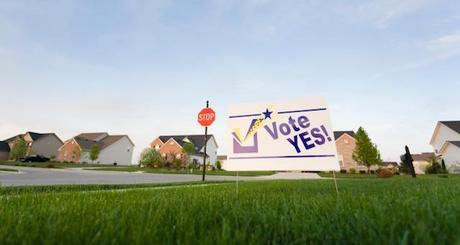
- October 22, 2014
- 0
- Email This Post
- Print This Post
What Businesses Can Learn from Election Year Lawn Signs
Poor Harry S. Truman didn’t have the convenience of modern advertising when he ran for president in 1948. Instead, he traversed the country, logging more than 31,000 miles and shaking more than a half million hands.
Since then, political candidates have adopted every emerging marketing tactic to win votes. The brief history of political advertising correlates the popularity of marketing trends with the election cycle. President Dwight D. Eisenhower was the first politician to take advantage of TV advertising. President John F. Kennedy plied his boyish good looks and charm to defeat Richard Nixon in the first televised presidential debates. Candidate William J. Clinton was even more daring, appearing on TV talk shows and MTV. Then Barack Obama changed the game, taking his message of “Hope” to young voters through social media and winning the 2008 presidential election.
Although it’s not a presidential election year, thousands of local, state and federal seats are up for grabs, and that means U.S. voters are exposed to a glut of political advertising.
Not Flashy but Effective
One of the first forms of political advertising remains the most popular and cost-effective: lawn signs. Also called yard signs, bandit signs, placards and road signs, these signs fit into tiny spaces to send a local message. For the politicians who use them, yard signs are economical and easy to distribute.
As an example, The Seattle Times reported that Gubernatorial Candidate Jay Inslee spent approximately $46,000 on signage during his last bid. Sterling Clifford, Inslee’s communications director, chalked up the advertising choice to efficiency.
And that efficiency can lead to votes. Although no study exists showing that yard signs sway the vote of people passing by them, The Atlantic recapped a study by a Fordham University professor who “found that having people hold signs at intersections encouraging people to vote, the day before an election, increased turnout in those neighborhoods.” In another study conducted by Auburn (Alabama) University, and reported by Slate, people who displayed a political sign, an American flag on holidays, or even some kind of banner or flags supporting the Auburn football team during football season, were 2.4 times more likely to vote than residents who displayed none of the above.”
Cast a Vote for Yourself
These are meaty directives for candidates and point out opportunities for any business or organization. Don’t think yard signs are only for candidates seeking votes:
- Real estate agents can promote their own brand, advertise an open house or call out amazing features on a listed property.
- Home contractors of any kind can promote their work by sticking up a yard sign bearing a simple message. For example, a landscaper could use yard signs with the endorsement: “Another home artistically landscaped by ABC Landscaping.”
- Even retail stores can use yard signs on their own properties. Try using yard signs to promote deals, reinforce customer service messages or acknowledge the “employee of the month” on the walkway leading up the store.
- Finally, show some spirit for your hometown high school or college teams with yard signs. This is especially uplifting if players on these teams live in your neighborhood (or even your own home!).
If you’re ready to branch out to other kinds of signage, read “Retail Signage Gives Pop to Pop-Up Stores,” “Signage – The Universal Tool of Today’s Successful Contractors” or “How Signage Helps Non-Profits Publicize Events.”
